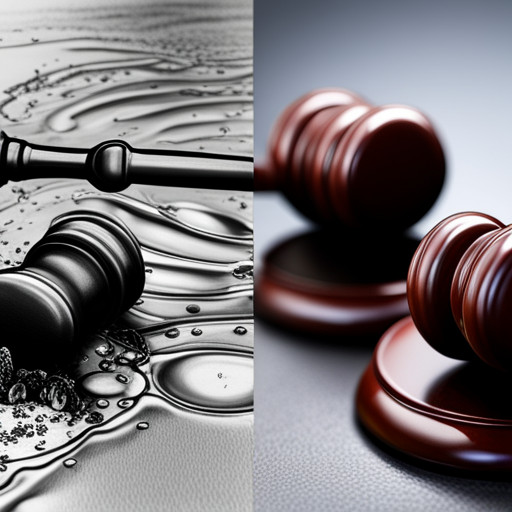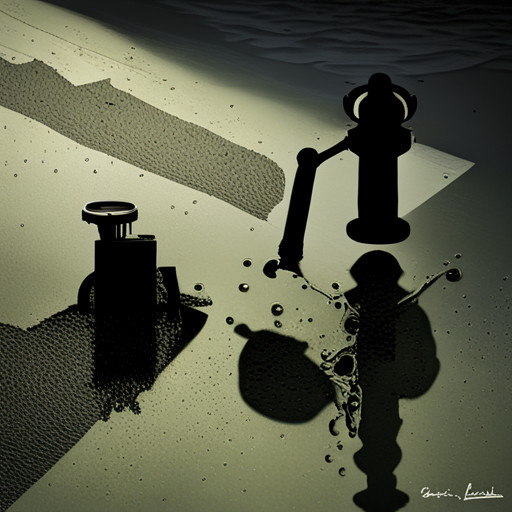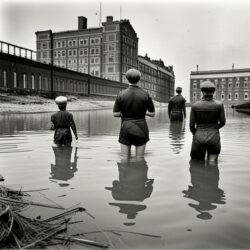Toxic Water Contamination and NonHodgkin Lymphoma Camp Lejeune Lawsuits
This article explores the linkage between toxic water contamination at Camp Lejeune, a North Carolina military base, and increased rates of non-Hodgkin lymphoma.

It delves into the history of this environmental disaster, the nature of non-Hodgkin lymphoma, research findings connecting the contamination to this disease, and the legal recourse available to victims.
Key Takeaways
- Camp Lejeune military base in North Carolina was exposed to toxic chemicals in drinking water from 1953 to 1987, leading to higher rates of non-Hodgkin lymphoma.
- The chemicals found in the water at Camp Lejeune include TCE, PCE, and benzene, which were several hundred times above EPA maximum safe levels.
- Non-Hodgkin lymphoma is strongly associated with exposure to the carcinogenic chemicals in the Camp Lejeune water, particularly TCE.
- The Camp Lejeune Justice Act allows victims of the water contamination to file civil lawsuits, with estimated settlement amounts for non-Hodgkin lymphoma cases ranging from $180,000 to $425,000.
The History of Camp Lejeune Water Contamination

The water contamination at Camp Lejeune military base, which began in 1953 and ended in 1987, exposed over 1,000,000 people to carcinogenic chemicals, including TCE, PCE, and benzene, with the water supply never tested for these impurities until the 1980s.
The source of contamination was traced to a dry cleaning business and the improper disposal of cleaning chemicals. Epidemiological studies have since linked the contamination to higher rates of non-Hodgkin lymphoma among residents.
This alarming history and impact of water contamination at Camp Lejeune led to legislative action, resulting in the Camp Lejeune Justice Act, passed in 2022.
This act provides legal rights and options for Camp Lejeune victims, allowing them to file civil lawsuits for injuries caused by exposure to the contaminated water.
Understanding Non-Hodgkin Lymphoma

Understanding this particular type of cancer requires a detailed exploration of its origin in the lymphatic system, its prevalence in the U.S., and its potential to occur in any part of the body.
Non-Hodgkin lymphoma, originating from lymphocytes, ranks seventh in cancer types in the U.S., with approximately 80,000 new diagnoses annually. This malignant condition can manifest anywhere in the body, often initiating in lymph nodes. Non-Hodgkin lymphoma causes are largely attributed to carcinogenic exposure, such as the water contamination at Camp Lejeune.
Non-Hodgkin lymphoma treatment options are determined by the disease's stage and the patient's health, often involving chemotherapy, radiation therapy, or stem cell transplantation. With a five-year survival rate of 84%, thorough understanding and timely intervention are crucial in managing this disease.
The Connection Between Toxic Water and Non-Hodgkin Lymphoma

Exposure to harmful chemicals such as TCE, PCE, and benzene, notably present in the drinking supplies of certain military bases during the 1950s to 1980s, has been linked to increased incidence of a specific type of cancer originating from lymphocytes. This correlation has been distinctly observed at Camp Lejeune.
- Long-term health effects of the contamination have been devastating.'
- The exposed population witnessed a surge in cases of non-Hodgkin lymphoma.
- Prevention measures were largely absent during the period of contamination; regular monitoring and chemical testing of drinking water were not in place.
The contamination episode underscores the importance of stringent environmental regulations and enforcement for public health protection.
Research Findings: Camp Lejeune and Non-Hodgkin Lymphoma

A significant correlation was discovered between the high incidence of a particular lymphatic system cancer and exposure to carcinogenic substances, notably present in the supplies of certain military bases from the mid-20th century, as per the results of numerous epidemiological studies.
Focused research on Camp Lejeune water contamination and non-Hodgkin lymphoma has indeed indicated a strong association. The incidence of this lymphatic cancer was notably higher among those exposed to the base's contaminated water.
This fact raises serious public health concerns, especially considering the extensive duration and the population potentially exposed to the contamination.
The findings imply that proactive measures are required to mitigate the effects of such environmental health hazards and underscore the need for stringent regulations to prevent future occurrences.
Legal Provisions for Victims of Camp Lejeune Contamination

Legislation passed in August 2022, known as the Justice Act, enables individuals affected by carcinogenic exposure at the military base in North Carolina to file civil claims. This law provides the victims of Camp Lejeune water contamination an opportunity to seek legal remedies and compensation options for the damages they suffered.
The Justice Act opens a window for victims to file lawsuits regardless of the statute of limitations and provides legal remedies to those who resided or worked at Camp Lejeune from 1953 to 1987.
Lawsuits can be filed for personal injuries resulting from the exposure, and the Act allows the estates of deceased victims to file wrongful death claims. It also underlines the government's recognition of the need for compensation options for victims of this environmental disaster.
The Process of Filing a Camp Lejeune Lawsuit

Initiating a civil claim related to the aforementioned environmental disaster requires understanding several key steps, including gathering necessary documentation, identifying responsible parties, and potentially obtaining expert testimonies.
The filing process commences with the compilation of medical records, exposure evidence, and other pertinent documents. Legal requirements mandate the identification of responsible parties, which, in the case of Camp Lejeune, involves the U.S. government and potentially other entities.
Expert testimonies may be garnered to substantiate the link between toxic exposure and disease manifestation. The claim is then filed within the stipulated timeframe per the statute of limitations.
Understanding these steps is critical, as adherence to the outlined process increases the probability of a successful claim in a Camp Lejeune lawsuit.
Eligibility Criteria for Camp Lejeune Lawsuit

Eligibility for filing a claim under the Camp Lejeune Justice Act is determined by specific criteria, primarily including residency or employment at the specified military base between August 1953 and December 1987, and demonstrable injuries caused by exposure to the polluted water supply.
Consideration of lawsuit eligibility also includes:
- Verification of residency or employment at Camp Lejeune during the affected period
- Medical documentation supporting health complications related to toxic water exposure
- A direct link between the health conditions and the contaminated water
- Absence of other potential causes for the health issues
- Timeliness of the lawsuit, filed within the statute of limitations
Compensation amounts vary depending on the nature and severity of the health issues, the impact on the claimant's life, and legal precedents in similar cases.
Case Studies of Successful Camp Lejeune Lawsuits

Several examples of successful legal actions related to adverse health effects from environmental exposure provide valuable insights into the potential outcomes for similar cases in the future. Case studies from Camp Lejeune lawsuits highlight successful outcomes achieved through the legal process. These lawsuits, primarily centered on non-Hodgkin lymphoma linked to toxic water contamination, resulted in substantial settlements for victims.
The passage of the Camp Lejeune Justice Act facilitated these lawsuits, allowing for the pursuit of civil actions against responsible parties. These case studies demonstrate the efficacy of legal action in addressing environmental health issues, offering hope for future claimants. They underscore the importance of robust legal frameworks in ensuring justice for victims of environmental health hazards, suggesting potential avenues for future litigation.
Estimated Settlement Amounts in Camp Lejeune Lawsuits

Settlement amounts for legal actions related to Camp Lejune range significantly, with estimates for cases involving non-Hodgkin lymphoma averaging between $180,000 to $425,000.
Various factors affect these settlement amounts, which include:
- The severity of the long-term health effects resulting from the exposure.
- The duration of the exposure to the contaminated water.
- The cost and complexity of medical treatments required.
- The impact of the illness on the quality of life of the victim.
- The strength of the evidence linking the exposure to the development of the disease.
- The plaintiff's age, cancer stage, and prognosis
- The degree of negligence proven in court
- The financial resources of the defendant
The Impact and Future Implications of Camp Lejeune Lawsuits

Moving from the determinants of settlement amounts in non-Hodgkin lymphoma lawsuits, the focus now shifts to the broader effects and potential future implications of the Camp Lejeune lawsuits. These lawsuits have not only served as a means of compensation for victims but have also shed light on the long-term consequences of water contamination.
The repercussions of these legal battles are far-reaching:
- They underscore the critical need for stringent regulations on water quality in military bases.
- The lawsuits highlight the long-term consequences of exposure to toxic chemicals.
These legal battles set a precedent for future water contamination cases and have led to increased awareness and research into the links between water contamination and cancer. They emphasize the government's responsibility to ensure safe living conditions for military personnel and their families.
Frequently Asked Questions
Can Family Members of Those Directly Exposed to the Camp Lejeune Water Contamination Also File a Lawsuit?”
Under the Camp Lejeune Justice Act of 2022, legal options are available for direct victims of the water contamination. The act primarily facilitates claims for those Marines or civilians who lived or worked at Camp Lejeune during the contamination period. However, the law does not explicitly extend compensation eligibility to family members of the directly exposed. Therefore, family members' ability to file lawsuits may be contingent upon specific factors and circumstances.
Legal advice should be sought for individual situations.
Are There Any Health Screenings or Tests Recommended for Those Who Lived or Worked at Camp Lejeune During the Contamination Period?”
Health screenings and tests are strongly recommended for individuals exposed to the water contamination at Camp Lejeune. These include regular cancer screenings, specifically for non-Hodgkin lymphoma. The frequency of these screenings may vary based on individual risk factors. The accuracy of these tests is critical to early detection and treatment of potential health issues.
Additionally, medical evaluations for other conditions linked to the contamination, such as liver, kidney, or neurological disorders, are advised.
Are There Any Ongoing Efforts to Further Clean up or Monitor the Water Supply at Camp Lejeune?”
Efforts to address the contamination impact at Camp Lejeune are ongoing. The primary focus is on remediation methods such as groundwater treatment and removal of contaminated soil.
Regular monitoring of the water supply is conducted to ensure safety standards. Additionally, numerous studies are undertaken to fully understand the long-term health effects of the contamination, thereby informing further cleanup and prevention strategies.
What Are the Symptoms of Non-Hodgkin Lymphoma That Former Residents or Employees of Camp Lejeune Should Be Aware Of?”
Non-Hodgkin lymphoma (NHL) presents various symptoms, essential for prompt lymphoma diagnosis. These include swollen lymph nodes, abdominal discomfort, chest pain, fatigue, unexpected weight loss, and recurrent fevers.
Given the historical environmental exposure at Camp Lejeune, former residents and employees should be vigilant for these symptoms. Regular medical check-ups are recommended for early detection of potential health issues, including NHL.
Are There Any Preventative Measures or Treatments Available for Those at Risk of Developing Non-Hodgkin Lymphoma Due to Exposure to Toxic Chemicals?”
Prevention of non-Hodgkin lymphoma in the context of chemical exposure primarily involves avoiding known carcinogenic substances.
Regular medical screening, as part of lymphoma awareness, may aid in early detection and treatment.
Therapies for non-Hodgkin lymphoma include radiation therapy, chemotherapy, immunotherapy, targeted therapy, and stem cell transplant.
The chosen treatment often depends on the type and stage of the disease, as well as the patient's overall health.




